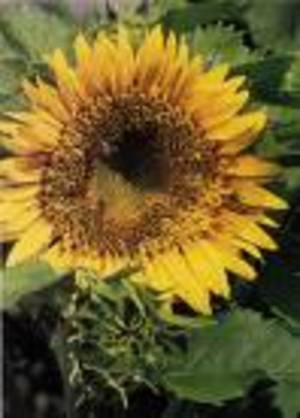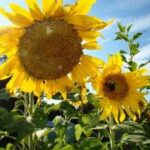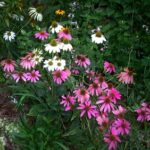Sunflowers are a gardener’s favorite! Children love watching the sunflower grow as they quickly tower over them. Sunflowers have been grown for many generations and more and more uses are being discovered for the seeds. Giant sunflowers can produce up to 2,000 seeds from one flower. The seeds can be harvested easily during the drying process and available for your use. I’ll cover some basic facts about sunflowers and some of the most common uses of the seeds.
Sunflowers come in many varieties and colors. The standard Giant Sunflower is the largest variety. You can find more decorative varieties in shades of yellow, black, red and white. The beautiful flowers grow very quickly and produce large beautiful blooms. The seeds need to be planted about ½ inch deep and covered lightly with rich soil or compost. Be sure to water the seeds after they emerge as seedlings to promote healthy growth.
After the seedlings are 3 inches tall, remove every other seedling, and any seedlings that appear weak so that there is ample room for growth. Remember the plants grow very large, very quickly, so you need to provide them with lots of room.
After the flowers have formed and the seed heads are appearing, the flower will droop over. This is a sign that the seeds are completing their formation and almost ready for harvest. The backs of the flower head should turn a lemon yellow color and the center of the flower will appear shriveled. This means the seeds are mature and the seed head is ready to be harvested. Cut the flower off while leaving about a foot of stem. This stem will give you something to hang the flower by.
Then hang the flower heads in a dry space such as a garage or outbuilding. Hang the flowers so that as the seeds dry they can fall off the flower head. Some people just place a basin under the seeds heads to catch the seeds, while others wrap a paper bag around the flower to catch the falling seeds.
After the seeds have fallen, they are ready for your use! One of the most basic uses for sunflower seeds is for eating. To prepare the seeds, you need to roast them. Start by covering the seeds with salt water. Make a mixture of 4 parts water to 1 part salt. You can change this ratio as you like. Soak the seeds overnight and then drain the seeds. Place the seeds on a shallow pan and roast in the oven at 300 degrees. The seeds will need to roast for about 30 minutes, or until they have turned a golden brown color. Some people then choose to butter the seeds and apply some more salt. This of course is up to you and the taste you desire.
Some other uses for the seeds include making sunflower oil. Sunflower oil is a healthy choice for vegetable oil to use for cooking. Sunflower oil is also a great seed choice for making biodiesel, which is far cleaner than regular petroleum based diesel.
Sunflowers also have a great capacity of removing toxins from the ground. Because of the size of the plants and the large root system, many of the toxins are absorbed from the ground and used by the sunflower. The sunflowers have even proven to remove uranium, a radioactive substance from water when grown using hydroponic methods.
I also like to use the sunflower seeds as bird seed. You don’t have to do anything other than allow the seeds to dry naturally. You can then place them into your birdfeeder, or spread them across the ground for the birds to enjoy. Sunflowers are a great seed to attract cardinals, one of the most beautiful winter birds in the Midwest.
Sunflower are fun to grow, easy to grow, and easy to produce seeds. If you have never grown sunflowers, give it a try, you’ll be glad you did!






